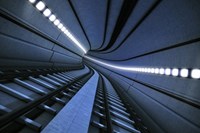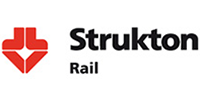
Trains, trams and other rail vehicles often produce squealing or grinding noises when they navigate a bend or switch. This is seen as a nuisance all over the world. Once considered a mark of prosperity, nowadays this noise causes considerable frustration for the residents of densely-populated areas. This subject gets a lot of attention in many countries. In the Netherlands, Strukton Rail and ProRail are developing a solution that prevents the noise of trains at track curves.
Trains moving along curves tend to make squealing noises. Lubricating (or, in technical terms, conditioning) the wheel flange and the rails helps to reduce this sound. Operators in various countries have had favourable experiences with different methods, both from the train and from the shore. Together with the private sector and transport companies, ProRail has established that conditioning solutions can also be utilised in the Netherlands, and that positive effects can be realised under operating conditions in this country.
Solution
Working in close collaboration with the commissioning client ProRail, Strukton has developed a solution for conditioning both the wheel flange and the rail tread from the moving train. This conditioning is activated as required and uses the optimal (i.e. minimal) amount of lubricant. At precisely-programmed moments, a system on board the train that is equipped with a pressure vessel and a pump sprays small quantities of ‘Headlub’ lubricant on the wheel flange and the rail tread. The system itself determines which quantity of Headlub is required at that point in time and at that location. It calculates this quantity on the basis of the train’s speed and position, the degree of stick-slip and other factors. This solution removes the need for stationary systems installed along the track. Strukton was able to successfully develop this system since it is one of the few companies in the world with systems expertise in the fields of both rail track and rail vehicles.
Less maintenance
The immediate reason for this search for a targeted wheel/rail conditioning solution was the wish to reduce noise nuisance. An additional advantage of the solution ultimately developed by ProRail and Strukton is that the train’s wheels move far more smoothly along the rails and switches. This significantly reduces wear at both ends. The system extends the respective lifespans of the rails and wheels and lowers maintenance costs. Traction friction – commonly referred to as ‘grip’ or ‘adhesion’ – is not affected.
Pilot projects
Between 2011 and 2014, ProRail and Strukton tested the system on two Connexxion trains on the Valleilijn route, five Veolia trains in the south of the country and eight NS trains deployed along routes throughout the Netherlands. These tests have yielded positive results. Even in the autumn, the tested systems did not have an adverse impact on the trains’ grip. Delft University of Technology and ProRail are presently analysing the test results to determine which percentage of trains should be fitted with the system to realise nation-wide coverage.
Follow-up in the Netherlands
In anticipation of the results of this analysis and a possible nation-wide rollout, Strukton has developed new, compact control units based on the experience gained in this programme so far. These new control units will be tested on trains operated by Connexxion and Arriva. The control units in the Connexxion trains are system-independent and rely on their own sensors. The control units in the Arriva trains are linked to the central train operation system. In addition, Strukton will be fitting the Arriva trains with data loggers that allow for the remote monitoring of data in real time.
About Strukton
Strukton Rail provides cross-border solutions in the field of rail infrastructure, railway vehicles and mobility systems. Through almost a century of rail construction involvement, maintenance expertise and technological development we have successfully adopted, created and connected past, modern and future best practises:
- Operational asset management
- Monitoring systems (POSS)
- Rolling stock systems
- Signalling systems
- Energy systems
- High-output equipment
- Training and certification




Comments
There are no comments yet for this item
Join the discussion